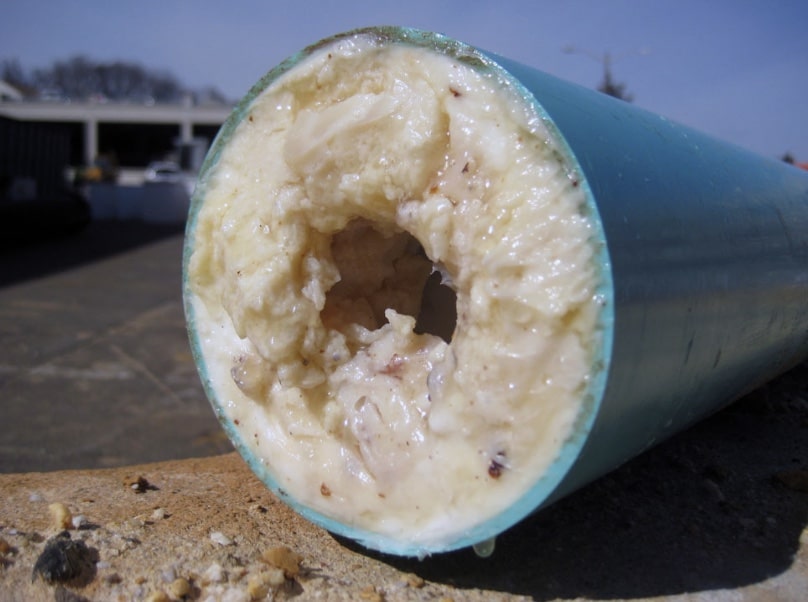Olive oil is liquid at 68 degrees fahrenheit but starts to solidify around 54 degrees. It becomes a gel around 45 degrees, and becomes a completely solid block at lower temperatures. So, if you pour oil down the sink when it’s liquid, it can solidify, and you end up with clogged pipes, backups, fines, citations and environmental damage.

You absolutely cannot thrown cooking oil down the drain. It clogs pipes, causes backups, flows into municipal water systems damaging equipment, causing backups for your friends and neighbors in beautiful Colorado. Used cooking oil thrown down the drain mixing with wipes is a major cause of Fatbergs, like this one in Fort Collins which clog municipal waterways and cost millions of dollars to clear.
A few restaurant workers at a Popeyes in Detroit disposed of cooking down a sewer grate and caused backups in many of their neighbor’s homes. One of the biggest fatbergs developed in London
Cooking oil that makes its way to bodies of water or disposed of on land can wreak havoc on birds, fish and aquatic animals.
Petroleum oils and used cooking oils that aren’t properly recycled have similar environmental impacts, according to the EPA. They can be toxic, destroy animal and fish habitats, and coat animals and plants, all of which produces oxygen depletion and destroys food supplies. The oils can destroy breeding animals.
Spilled oil can harm living things because its chemical constituents are poisonous. This can cause skin and eye irritation. If animals inhale or consume the oils, it can wreak havoc on their insides.
The oil can also reach natural water reserves, which puts the lives of aquatic and marine creatures at risk. Oil can also smother some small species of fish or invertebrates and coat feathers and fur, reducing birds’ and mammals’ ability to maintain their body temperatures. If cooking oil reaches the water, it can kill aquatic life forms and birds by coating them with a thick layer of sludge. This reduces their ability to breathe, which can lead to them choking to death.
The City of Aurora, for example, advises against disposing of cooking oil in the ground or near lakes or streams. Oil can spread very thinly across water over a large area changing the chemistry and health of the ecosystem. You should never dispose of any oil near lakes, streams or watersheds. Even placing the oil in the trash as a liquid could mean that it could leach out of the landfill and into the ground and surrounding area and watersheds. Years ago people would use cooking oil to kill weeds. That same mechanism of strangling weeds by depriving them of oxygen and nutrients is why cooking oil should not be disposed of in the garden.
Since the Clean Water Act of 1972, the EPA has regulated what can be discharged into public waterways, which in turn regulates what restaurants must do with used cooking oil. Illegal discharge of cooking oil can harm the restaurant, public waterways and your neighbors. The ramifications in terms of fines, citations and closures can be substantial.
The Colorado Department of Public Health and Environment (CDPHE) regulates hazardous waste management, including cooking oil disposal. Additionally, individual cities may have their own regulations for the disposal of used cooking oil.
The city of Pueblo, for example, has a complete Grease and Oil Management Program as does Telluride.
When cooking oil is recycled from restaurants and food processing companies most of it goes to produce cleaner burning biofuels. Biodiesel, renewable diesel and SAF (Sustainable Aviation Fuel) are the final products. Your cooking oil recycler, Aspen Oil, takes your cooking oil to their warehouse and performs the first few steps to filter the oil in order to make it ready for sale to a biofuels producer. This means removing water, impurities and contaminants to meet the standards of biofuel producers.
Recyclers carefully measure to determine FFA(free fatty acid) levels and MIUs (moisture, insolubles and unsaponifiables). Biodiesel producers won’t buy the oil unless it is less than 10% FFA and less than 2% MIU.
After the filtered UCO is sold to a biofuels producer the oil goes through a different process to make the three biofuels:
UCO goes through a process called transesterification to become biodiesel. It goes through hydroprocessing and several chemical processes to become renewable diesel. UCO goes through a process called HEFA (Hydrotreated Esters and Fatty Acids) to become SAF (Sustainable Aviation Fuel). Chemistry aside what are the benefits of these biofuels?
Compared to diesel fuel, biofuels, particularly biodiesel, offer quantifiable benefits in significantly reduced emissions of particulate matter, carbon monoxide, sulfur dioxide, and hydrocarbons,
When compared to regular diesel, biodiesel emits 74% less when compared with a full lifecycle analysis. However, biodiesel must be blended with regular diesel to be used as a fuel.
Renewable diesel has a 85% lower carbon footprint when compared with petroleum diesel. Renewable diesel is a “drop-in” fuel which means it performs exactly like a regular diesel and does not need to be blended.
Sustainable Aviation Fuel (SAF) can reduce carbon emissions by up to 80% compared to traditional jet fuel.
And the transportation sector contributes about 28% of total US based GHGs according to the EPA. The transportation sector is the largest contributor to US based Green house gases.